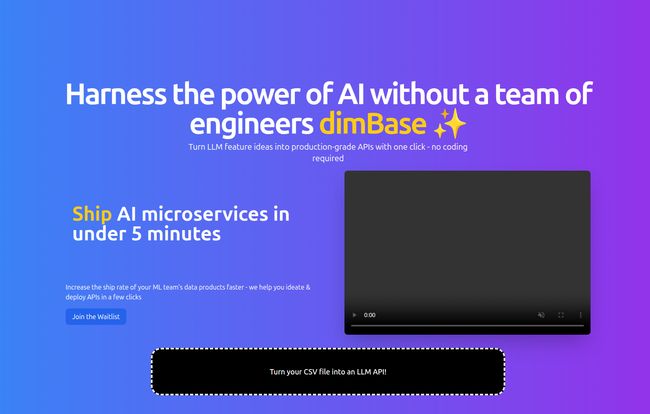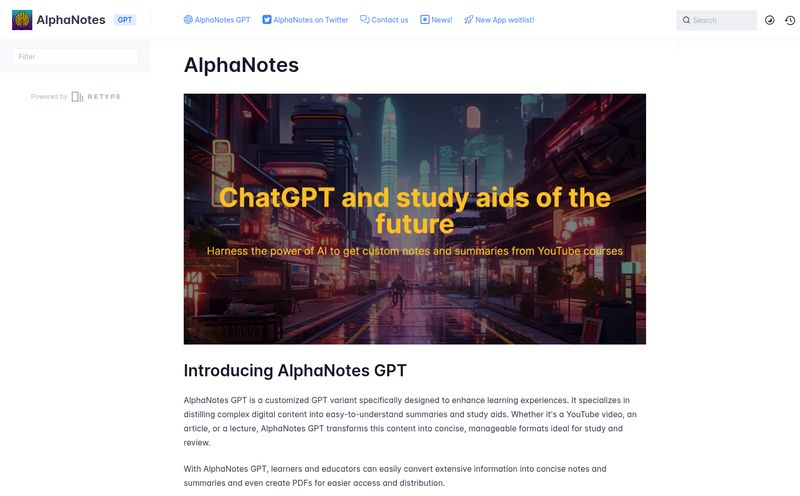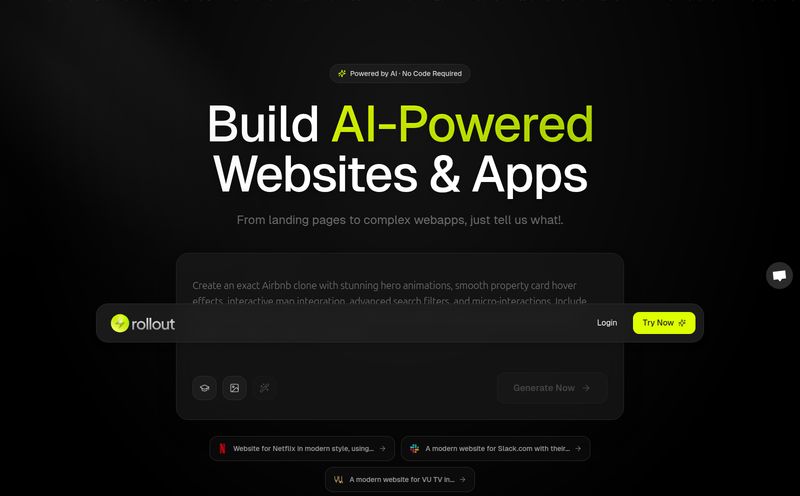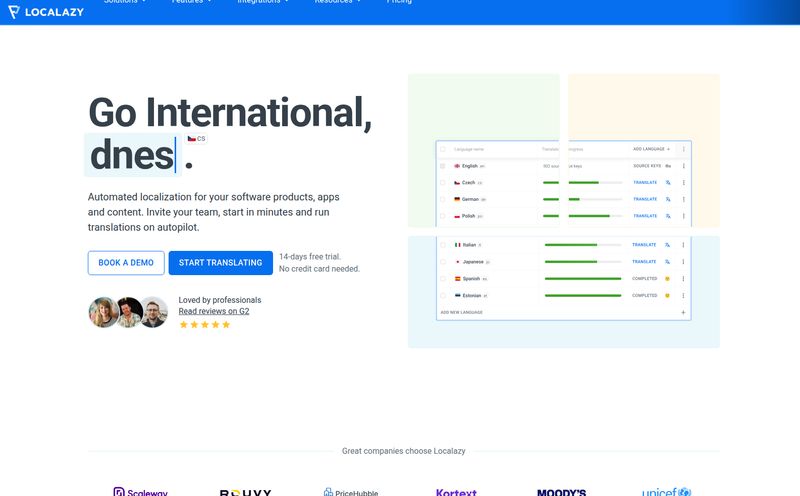I've been in the SEO and digital marketing game for a long time. Long enough to remember when just having a mobile-friendly website was considered cutting-edge. Now, we're all caught in the whirlwind of the Great AI Gold Rush. Every company, from the tiniest startup to the most monolithic corporation, is scrambling to bake AI into their products. And honestly? It's been a bit of a mess.
You’ve seen it, right? A brilliant idea for an LLM feature gets cooked up in a product meeting. Everyone's excited. The potential is massive! Then it gets handed over to the engineering queue, where it sits... and sits... and sits. It becomes this colossal game of telephone between Technical Program Managers (TPMs) trying to spec things out and the ML teams who are already buried under a mountain of other 'top priority' tasks. Weeks, sometimes months, evaporate. By the time the feature finally sees the light of day, the market has already moved on.
So when a tool like dimBase pops up on my radar, flashing promises like “Ship AI microservices in under 5 minutes,” my inner cynic and my inner optimist get into a fistfight. The cynic says, “Yeah, right.” But the optimist, the one who genuinely loves tech that solves real, gritty problems, leans in a little closer.

Visit dimBase
So, What Exactly is dimBase?
Let's cut through the marketing fluff. At its core, dimBase presents itself as a no-code platform designed to take the agony out of deploying custom LLM APIs. Think of it as a superhighway that bypasses the usual traffic jams between the idea department and the deployment dock. The whole point is to empower the people who aren't ML engineers—the TPMs, the Product Managers, the data-savvy marketers—to turn their ideas into tangible, working, production-grade APIs without having to write a single line of code.
It’s a bold claim, but one that speaks directly to a massive pain point in the industry right now. The barrier to entry for AI ideation is low, but the barrier to implementation is sky-high. dimBase wants to bulldoze that barrier.
How dimBase Promises to Change the Game
I’ve seen a lot of “no-code” solutions that are anything but. They often require so many workarounds and technical gymnastics that you might as well have learned to code in the first place. But dimBase seems focused on a few very specific, very powerful features.
From a CSV to a Live API? Seriously?
This is the one that really got my attention. The landing page shouts, “Turn your CSV file into an LLM API!!” And okay, that sounds almost too good to be true. But imagine the possibilities. You have a spreadsheet with product descriptions and categories, and you want an API that can auto-categorize new, user-submitted items. Or maybe you have a list of customer support queries and their resolutions, and you want an API that suggests answers for your support team. Traditionally, that's a whole project. With dimBase, the pitch is that you just… upload the file. It feels a bit like magic, and I’m very curious to see the nuts and bolts behind how it handles the data mapping and model fine-tuning.
Comparing Models on the Fly
Another interesting feature mentioned is the ability to instantly compare models. This is huge. Anyone who’s worked with LLMs knows that not all models are created equal. GPT-4 might be great for creative text, but a smaller, faster model from Cohere or Anthropic might be better and cheaper for a simple classification task. The ability to test-drive different models for your specific use case without a complicated setup process is a massive time-saver and a smart way to manage costs. It stops you from using a sledgehammer to crack a nut, which is a very common and expensive mistake in the AI space.
Who is This Really For?
While the obvious answer is TPMs and ML teams, I think the potential audience is wider. I see this being a godsend for:
- Product Managers: Quickly prototype and validate AI features without pulling in engineering resources for every little experiment. This accelerates the feedback loop tremendously.
- Data Analysts: They're already sitting on troves of valuable, structured data in CSVs and databases. This gives them a path to make that data interactive and operational.
- Scrappy Startups: For small teams that don't have a dedicated ML engineer on payroll, this could be the tool that lets them compete with the big guys. It levels the playing field, a little bit.
It’s all about speed and autonomy. It's about letting the people with the contextual business knowledge build the tools they need, right when they need them.
The Good, The Bad, and The Waitlist
Alright, let's get real. No tool is perfect, especially one this new. From what I can gather, here’s the breakdown.
On the plus side, the value proposition is crystal clear and incredibly strong. Fast deployment. No coding. Bridging the gap between teams. These aren't just features; they're solutions to chronic, expensive problems. The promise of seamless integration with existing tools is also a big tick in the pro column, though I’d love to see a concrete list of which tools they mean. Is it Jira, Slack, Zapier? The details matter.
On the other hand, the biggest drawback right now is access. It's currently behind a waitlist. This is pretty standard for hot new tech platforms—it helps them manage scale and get feedback from early adopters. But it does mean you can’t just sign up and start playing around today. There's also a general lack of deep-dive information. The website gives a great high-level pitch, but I'm hungry for more details on the specific integrations and the technical underpinnings. But then again, a little mystery can be exciting, cant it?
Let's Talk Pricing (Or the Lack Thereof)
As of right now, there's no public pricing page. This isn't a red flag, just a sign of its early stage. I'd speculate we'll see a tiered SaaS model when it launches fully. Perhaps a free tier for small experiments, a pro tier for small businesses, and an enterprise plan for larger organizations needing more robust features and support. Pricing will likely be based on factors like the number of API calls, the number of deployed models, and the level of support required. It’s a space to watch.
My Final Take: Is dimBase Worth Watching?
Yeah, I think so. In an industry absolutely drowning in hype and vaporware, dimBase feels refreshingly practical. It’s not trying to solve every AI problem in the universe. It’s targeting a very specific, very painful bottleneck: getting LLM features out of spreadsheets and into production.
If they can deliver on the promise of turning a CSV into a production-grade API in just a few clicks, they won't just have a successful product; they'll have a genuine game-changer. It could fundamentally alter how product teams operate and how quickly businesses can innovate with AI.
I've joined the waitlist. The proof, as they say, is in the pudding. I suggest if you're feeling that all-too-familiar pain of AI development cycles, you might want to get in line too. This could be one to watch.
Frequently Asked Questions about dimBase
- What is dimBase in simple terms?
- dimBase is a no-code tool that helps you create and launch custom AI-powered APIs very quickly, supposedly in minutes. It's designed for people who aren't expert programmers, allowing them to turn ideas and even simple CSV files into working AI features.
- Do I need to know how to code to use dimBase?
- No, that's its main selling point. The platform is built to be a no-code solution, meaning you can create, deploy, and manage LLM APIs through a user-friendly interface without writing any programming code.
- Who is the ideal user for dimBase?
- It's primarily aimed at Technical Program Managers (TPMs) and product teams who need to prototype and ship AI features fast. However, it's also incredibly useful for data analysts, marketers, and small business owners who want to leverage AI without hiring a dedicated ML team.
- How can I get access to dimBase?
- Currently, access to dimBase is available by joining a waitlist on their official website. This is common for new platforms as they scale up their infrastructure and user base.
- Is dimBase free?
- There is no public information about pricing yet. It's likely that once the platform launches fully, it will have a tiered pricing structure, which might include a limited free plan for trial and small projects.
- What kind of AI models can I use with dimBase?
- The platform advertises the ability to do instant model comparisons, which suggests you'll be able to choose from various popular Large Language Models (LLMs) to power your API, though a specific list isn't available yet.
Reference and Sources
- TechCrunch: The rise of no-code and low-code platforms for AI (Note: This is a representative link for context, not a direct source from the platform.)



